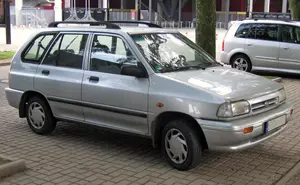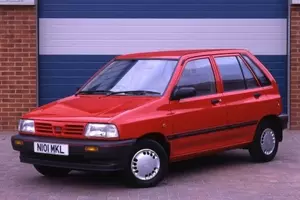
| Vehicle | Curb weight | Difference from world's smallest | Weight to power ratio | 0—60 mph acceleration ratio | Consumption ratio |
|---|---|---|---|---|---|
| 1.3 i |
900 kg / 1985 lbs |
475 kg (1048 lbs) heavier | 14 kg to 1 hp | - | - |
| Vehicle | 1.3 i |
|---|---|
| Curb weight |
900 kg / 1985 lbs |
| Difference from world's smallest | 475 kg (475 lbs) heavier |
| Weight to power ratio | 14 kg to 1 hp |
| 0—60 mph acceleration ratio | - |
| Consumption ratio | - |

| Vehicle | Curb weight | Difference from world's smallest | Weight to power ratio | 0—60 mph acceleration ratio | Consumption ratio |
|---|---|---|---|---|---|
| 1.3i |
795 kg / 1753 lbs |
370 kg (816 lbs) heavier | 11 kg to 1 hp | 61 kg/s (135 lbs/s) |
106 kg/L (234 lbs/L) |
| 1.1 i |
850 kg / 1874 lbs |
425 kg (937 lbs) heavier | 16 kg to 1 hp | 66 kg/s (146 lbs/s) |
116 kg/L (256 lbs/L) |
| 1.3 i |
795 kg / 1753 lbs |
370 kg (816 lbs) heavier | 13 kg to 1 hp | 54 kg/s (119 lbs/s) |
106 kg/L (234 lbs/L) |
| Vehicle | 1.3i |
|---|---|
| Curb weight |
795 kg / 1753 lbs |
| Difference from world's smallest | 370 kg (370 lbs) heavier |
| Weight to power ratio | 11 kg to 1 hp |
| 0—60 mph acceleration ratio | 61 kg/s (135 lbs/s) |
| Consumption ratio |
106 kg/L (234 lbs/L) |
| Vehicle | 1.1 i |
| Curb weight |
850 kg / 1874 lbs |
| Difference from world's smallest | 425 kg (425 lbs) heavier |
| Weight to power ratio | 16 kg to 1 hp |
| 0—60 mph acceleration ratio | 66 kg/s (146 lbs/s) |
| Consumption ratio |
116 kg/L (256 lbs/L) |
| Vehicle | 1.3 i |
| Curb weight |
795 kg / 1753 lbs |
| Difference from world's smallest | 370 kg (370 lbs) heavier |
| Weight to power ratio | 13 kg to 1 hp |
| 0—60 mph acceleration ratio | 54 kg/s (119 lbs/s) |
| Consumption ratio |
106 kg/L (234 lbs/L) |